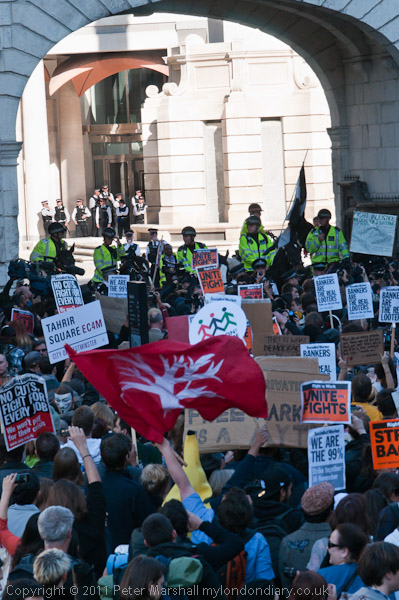I was sorry to hear about the eviction of Occupy London from their site outside St Paul’s Cathedral, although it had seemed inevitable. Last Thursday afternoon, when I was standing on a hillside in Derbyshire I got a text message suggesting I might like to photography at the St Paul’s camp later that evening when they would be taking some of their tents down to move elsewhere, and was sorry I was unable to go and do so, but it was a sign that some at least of those occupying had decided to move before they were pushed.
Monday night and Tuesday morning when the eviction happened I was back home and in bed with my phone and computer turned off, and only heard the news the next morning. But in any case, although I only live a little over 20 miles away, it isn’t too practicable for me to get to London in the middle of the night – it would take me a couple of hours on my bike.
I knew of course that other photographers would be there, covering the events more or less from the start, so there was little point in my making the effort had I been awake.

A message for St Paul’s from OccupyLSX on the morning they started
I was sad to hear what happened, because OccupySLX has I think had an impact that few of us could have predicted, creating and influencing public debates about issues that would otherwise have remained brushed under the carpets. And of course the eviction doesn’t end the Occupy movement in London, with one site, Finsbury Square, still going and few would dismiss the chance that others may begin (certainly the police haven’t.) But what we have seen so far doesn’t deserve the gloating that some politicians and bloggers have been making much of over the last day. It is very much a story of success that we should celebrate – and hope for the future.

The meeting on Westminster Bridge, October 9, 2011
Few of us who were at the general meeting on Westminster Bridge on October 9, six days before the occupation started that took a decision to occupy the Stock Exchange thought that this had any chance of success.

OccupyLSX blocked at Temple Bar in sight of the Stock Exchange
And when it failed on October 15, to many this seemed the end. Even when it became clear that some of those present were determined to set up camp in front of St Paul’s, many predicted it would be cleared within 24 hours. Even the most optimistic of us thought that it would certainly all be over well before Christmas – certainly when the first cold weather came.

OccupyLSX still at St Pauls in February 2012
But of course it stayed much longer than the few weeks most people gave it. And it didn’t just stay, but spawned other sites, including Finsbury Square, the nearby Bank of Ideas, a court in Shoreditch etc. Only Finsbury Square currently remains, as the School of Ideas was also evicted on Monday night – and to make sure it stayed evicted bulldozers flattened it early on Tuesday morning.

Occupy Finsbury Square in Nov 2011
It didn’t just stay. It worked, it protested, it taught. It attracted many influential and well-known names to come and visit, to give their support and talk. At first people may have laughed at the idea of the “tent university” but it became something of a graduate school.
I’m not a part of Occupy London, although I sympathise with many of the ideas they put forward. I dropped in for the occasional visit, often when passing on my way to other things, but didn’t have the time to commit to being a part of it. I’m not sure I would have done even so, as there were things I was uncomfortable with, apart from being rather old and fixed in more comfortable ways. But I am sure that their presence has enriched London. And I look forward to more of the story.






